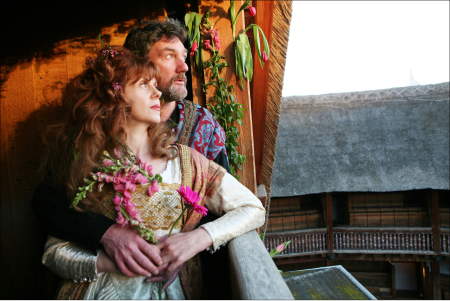
Director Conall Morrison manages to turn one of Shakespeare’s most beloved (and controversial) comedies into a horrifying study of abuse. Performed mostly in the style of commedia dell’arte, moments of psychological realism in The Taming of the Shrew are made all the more harrowing. If the heavy handed symbolism and relentless crudeness can be stomached, this portrayal of extreme sexism and sexual fantasy drives its point home.
This version opens with the drunken Christopher Sly (a convincingly pathetic Stephen Boxer) at a modern day bachelor party. After being booted out of a strip club and passing out, several passers-by decide to trick him into thinking that he is a nobleman. In a painful moment of deluded enthusiasm, Sly convinces himself that he is indeed a lord. A group of traveling players (played with exaggerated relish by the cast) arrives in a truck and is paid to perform a play for the “noble lord.”
Thus the story is thrown back into the Elizabethan era, the x rated video store and hotel is turned into a tower of Renaissance Padua, and actors don colorful clothes which are parodies of Elizabethan dress. Love (or rather, lust) triangles ensue, identities are mistaken, and typical Shakespearean comedic plotlines follow, making the relationship between the titular “shrew” Katherina (Michelle Gomez) and her mercenary pursuer and “tamer” Petruchio (also Boxer) especially disturbing.
Boxer makes a brilliant transition from the miserable, bewildered Sly to a powerful, sadistic Petruchio. Gomez likewise impressively transits from the initially screeching Kate to a woman whose identity has been annihilated. Intentionally comic speeches are spoken instead with overbearing viciousness. All sense of playfulness has been removed from Petruchio’s taming of Kate.
This Petruchio bashes and chokes his servants, particularly Grumio (William Beck), in scenes of slapstick, but cruel, violence. Beck is difficult to watch in a usually humorous role, reduced by brutality to a shuddering animal. Indeed, Petruchio occasionally throws his him meat as one would to a dog and even rides on him as his “horse” to the wedding. When Grumio finally has the upper hand over Kate, he gleefully torments her.
Petruchio’s treatment of Kate is likewise upsetting, partly because they do have chemistry. Before their first, sexually charged (if violent) encounter, he throws her an apple, into which she bites. Kate is heart-rending as she entreats Petruchio to stay after their wedding, but he is determined not to allow one inch of defiance until his wife essentially admits that 2+2=5. Instead of offering support, the buffoonish townsfolk push Kate, one social disrupter, to Petruchio, another disorderly, as though she were a sacrifice to a god. That they mistake Petruchio for a monster is not surprising, considering he marries while wearing a hideously grotesque outfit.
This torture is set amongst a host of cartoonish characters. The prancing, hilariously moronic Lucentio (Patrick Moy) falls instantly in love with Bianca (Amara Karan), Kate’s coy, supposedly meek, younger sister. Two of her other suitors include the elderly Gremio (a hysterical Peter Shorey) and the ridiculously dressed, but slightly younger, Hortensio (Sean Kearns). Keir Charles plays Lucentio’s somewhat clever servant Tranio, who puts on a ludicrous accent while standing in for his master as Lucentio woos Bianca in disguise.
Eventually, the outcast couple and community are reconciled. At this point, Elizabethan costumes have shifted back to modern dress, emphasizing the endurance of sexism. The completely broken Kate’s long, final speech, sometimes touted to be a beautiful commentary on marriage, is gut-wrenching.
This interpretation of The Taming of the Shrew is one track minded and vulgar, intentionally playing to the lowest kind of mindset. Perhaps because of this, Morrison succeeds in hurling questions of misogyny and power to the forethought in a night of uncomfortable, and unforgettable, theater.




